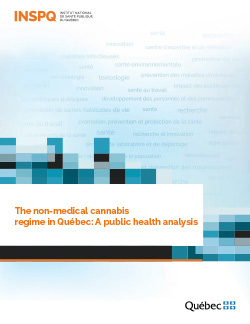The non-medical cannabis regime in Québec: A public health analysis
- This document examines, from a public health perspective, the regulatory regime governing the production, distribution, use and possession of cannabis for non-medical purposes in Québec. The analysis describes the main characteristics of this regime and examines the main public health issues it raises. Thus, the analysis identifies elements that could inform the legislative review process planned for 2021.
- Compared to what has been put in place in other Canadian provinces and in other countries, the Québec regime has some distinctive characteristics:
- The fully public nature of the distribution and sales system is unusual. The Société québécoise du cannabis, a not-for-profit state-owned enterprise, holds a monopoly on the purchase and sale of cannabis products for non-medical purposes to individuals in Québec. Compared to partially or fully privatized regimes, this monopoly allows for more direct control over cannabis products and their prices, the retail environment and promotional advertising.
- Québec's regulatory regime for distribution prioritizes prevention and harm reduction, rather than private or government profit. Only Uruguay, among the jurisdictions studied, has similar objectives. Thus, the mandate of the Société québécoise du cannabis includes explicit objectives aimed at protecting the health of the population and ensuring that the legal market for cannabis does not encourage increased consumption. In most other jurisdictions, explicit statements regarding limiting use apply solely to youth.
- The manner in which distribution prohibitions are managed is also a distinctive aspect of the Québec regime. For example, under the federal Cannabis Act, distribution to another person of more than 30 grams of dried cannabis or its equivalent is subject to a criminal penalty. Québec’s Director of Criminal and Penal Prosecutions, on the other hand, has determined that many federal offences of this nature can be dealt with non-judicially by their prosecutors.
- Québec's regulatory regime for cannabis has already evolved significantly since legalization came into effect in October 2018. It will likely continue to do so, whether in terms of regulations, policies or marketing practices. This regime will have to be monitored to ensure that it remains consistent with its public health objectives. Three important elements to be monitored emerge from the analysis:
- Studies of public alcohol monopolies tend to demonstrate that this model is the most likely to limit increased consumption. This gives cause to consider maintaining the Québec model, despite various expressions of interest in its privatization.
- How to balance the tension between the objectives of not increasing cannabis use and of redirecting users from underground networks toward legal purchases will require constant and careful consideration. As the situation in other jurisdictions demonstrates, the downward trend in cannabis prices and the wide availability of cannabis products have contributed to an increase in the prevalence of cannabis use. This points toward a precarious balance between these two objectives.
- The Québec regime includes a relatively large number of restrictions and prohibitions, such as a general ban on smoking in public. The Act also allows third parties to introduce bans in a significant number of private locations (rental units, condominiums, etc.). The Act sets the age for access to authorized products at 21 years old and prohibits cultivation at home for personal use. The current state of knowledge on the effects of prohibitive measures indicates that they are likely to generate social inequalities in health and that these can be at least partially mitigated by harm reduction measures. Further to this, it will be important to monitor the frequency, nature and social distribution of sanctions to ensure that certain groups of people are not more affected than others due to their characteristics (e.g., age) or the vulnerable context in which they live.


